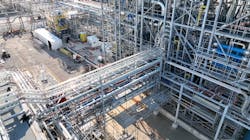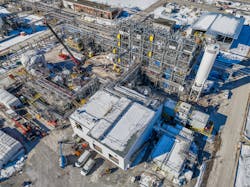Origin Materials Branches Out: Turning Wood Residues into Sustainable Gold
Origin Materials Inc. is building sustainable materials from the ground up. The West Sacramento, California, chemical start-up began production at its first plant in Sarnia, Ontario, on June 28.
The company says its plant, called Origin 1, is the world’s first to commercially produce a chemical made from wood residues called chloromethyl furfural (CMF).
CMF is a versatile chemical building-block that can be used to make numerous downstream products, including para-xylene, which is the precursor to PET plastic, and FDCA (furandicarboxylic acid), which can be used in numerous sustainable products and materials such as the next-gen polymer PEF (polyethylene furanoate). The plant will also produce HTC (hydrothermal carbon), whose applications include sustainable carbon black for automotive tires.
The company considers the plant’s startup to be a major milestone for its technology platform of converting sustainable wood residues into versatile intermediate chemicals. Unlike existing chemical operations that are challenged to integrate sustainable feedstocks into their materials, Origin’s entire operation is built to process biobased raw materials.
Origin’s story dates back to 2008 when University of California, Davis chemical engineering students John Bissell and Ryan Smith co-founded the company. The company employs about 200 people, with 25 at the Sarnia plant. The company expects to hire another 200 employees in 2025 when production begins at its Geismar, Louisiana, plant, which is currently under construction. The plant, called Origin 2, will produce sustainable carbon-negative materials used to make products such as polyethylene terephthalate (PET) plastic.In June, Chemical Processing spoke with Bissell, Origin's co-CEO, about his company’s mission and goals.
CP: Tell me a little bit about your company and why you started it.
JB: I think we were really looking for a way to understand and bring technology to the chemical industry at large. I don't know that we really understood that very formally, but that was what we were trying to get after. And we sensed there was a problem that wasn't being addressed very well, which we thought of then as sustainability, or now, decarbonization. When we initially started the company, we had a technology in mind, but I don't think we felt very attached to a particular technology. We were young kids. We wanted something that we could sink our teeth into, I guess you could say.
CP: Who are your primary customers?
JB: It's an interesting question. Our direct customer is typically a chemical company of some sort or maybe a polymer converter. Let’s take para-xylene as an example. When we're making para-xylene, it's going to have to get converted into terephthalic acid, and then PET, and then it gets sold to a consumer products company, and then it finally makes it to the ultimate consumer. Nominally, it's a company that makes terephthalic acid that is our direct customer. But the reality is that we found pretty early on that the party that's [driving sustainability] is the party that's closest to the consumer typically, and they're the ones that are informing the value chain. So, we often treat the consumer products companies as our customer.
CP: I understand that you're using wood as the primary feedstock. Is that correct?
JB: Yeah, so we can use pretty much any lignocellulose material. That means wood is fine, crop residues are fine. Really, it's the C6 monomer that we're using in cellulose to make the CMF, so you can use starch, you could use sugar. It just turns out that lignocellulose is usually a lot cheaper than starch and sugar, so we gravitate in that direction. It's much more straightforward to ship wood and wood byproducts than it is crop residues, for example. If you want to ship corn stover around, you really have to set up your value chain and supply chain for corn stover. It doesn't really exist right now. If you want to ship parts of wood around, there's a supply chain for that; people do that already; they're paying attention to it; there's a market price; you can go into the market and buy. It's much more straightforward to get started with that. That was a big driver for us on starting with wood products, not because it was necessary for the technology but because it limits the number of things that we have to go figure out and do.
CP: So how, how do you source it?
JB: There are a bunch of different ways to source it. For our plant in Geismar, Louisiana, we expect to use almost all residuals from the forest products industry. So what that means is, there are various points in the production of dimensional lumber or pulp where there's sort of leftovers or lower-value leftovers, let's call it. And perhaps the pithy answer is, if you're taking dimensional lumber, you're taking a cylinder, and you're reducing it to a rectangular prism, there's extra, and that extra ends up as chips, sawdust, all sorts of stuff. We can take all that, and it's just as good to us as a high-grade material of some sort. We can call up the sawmills and say, “Hey, we'll buy your stuff; send it to us.” And sawmills are pretty big, so it doesn't take a lot of sawmills to get a lot of material.
CP: So how, how does the manufacturing process differ using wood versus a traditional carbon feedstock?
JB: So, it’s a completely different process and chemistry until you get to para-xylene, and then once you've made para-xylene, it's exactly the same as the process to make PET right now. So, we sort of merge in with the existing supply chain. We put wood chips in a reactor. Physically, this sort of looks like the process to make pulp, but the chemistry is completely different inside the reactor. Once you get in the reactor, it's a mixed liquid and solid phase [system]. You have two liquid phases, and you have two solid phases. One solid phase is the feedstock— the wood chips that are being digested. The other solid phase is the HTC that we're producing, which sort of looks like used coffee grounds.The two liquid phases: There's an aqueous phase, which is where the reaction's happening principally. And then there's an organic extractant phase because it's a reactive extraction. That’s where we make the CMF, and that's where it gets protected from the processing environment, which is how you end up with high yield. From there, it's all just separations to make the HTC, the CMF, and, as I said, we have a couple of minority species. Once you have your CMF isolated, it's, packed-bed hydrogenations. You reduce it down to DMF (dimethylfuran), down to furan, and then you have another unusual reaction, which is a Diels-Alder cycloaddition reaction of dimethylfuran with ethylene. And then, dehydration, which aromatizes the system, so you pull off water, and you end up with para-xylene.
What's kind of interesting about that is, I don't know of any sort of Diels-Alder dehydroaromatizations that’s going on anywhere in the industry right now, so the chemistry's pretty novel, actually. But the processing's relatively straightforward; it's homogeneous catalysis—high-pressure, moderate temperature, but the chemistry is somewhat unique, which is kind of cool.
CP: Having that unique chemistry and this unique process, did that present any challenges for you on an operational level?
JB: We’re bringing our first plant online right now, so we haven't gotten a chance to run anything at scale yet to tell you if it’s presented operational difficulties. But I'd say one thing that's kind of interesting about developing new chemistry this way is you have to have a really strong analytical system for that. The reality is actually that a lot of companies that we work with are just not sort of prepared for a new analytical suite to be dropped into their system.
It doesn't even occur to them that that's something they have to worry about. They’re so used to dealing with fossil systems, which have characteristics to them that are common that they don't think about it. We developed an understanding about the robust ways to analyze new systems. What do you need to watch out for? How do you develop those methods appropriately? How do you quantitate them? We’ve seen a lot of bad habits in the industry just because they're dealing with systems that are so well known—you can take a bunch of shortcuts, and they don't even remember that they're taking shortcuts.
CP: Have you run into any challenges finding skilled talent to fill positions?
JB: So we thought it was going to be a challenge. We took the company public in 2021 and scaled up pretty rapidly to go build this plant in Canada and then build the plant down in Geismar, Louisiana. Of course, hiring and scaling a company that fast (18 months) is hard, but man, we got great talent. I think we sort of offer a different life in some ways than the legacy chemical companies do. You're going to get to make a ton of design decisions and a ton of process-development decisions, and it's going to get built fast. You're going to get to see it through the full lifecycle. You're going to be really hands on all the way through, and get to understand the intersection of all the different disciplines that matter.
You're not being sort of siloed off into your specific core discipline. You're having to integrate across all those sorts of things. You’re working tightly with customers at the same time you're doing all these other things. I mean, it's just a somewhat fluid startup environment. And there aren't a lot of those in the legacy chemical industry, or the oil and gas industry. People care about that. They love that. So, we get great folks. … [Also], a lot of engineering in the chemical industry happens remotely anyway. So, we basically said, for the disciplines where it makes sense, let's go full remote.
And so that gave us an even another layer to get access to just unbelievable talent.
About the Author
Jonathan Katz
Executive Editor
Jonathan Katz, executive editor, brings nearly two decades of experience as a B2B journalist to Chemical Processing magazine. He has expertise on a wide range of industrial topics. Jon previously served as the managing editor for IndustryWeek magazine and, most recently, as a freelance writer specializing in content marketing for the manufacturing sector.
His knowledge areas include industrial safety, environmental compliance/sustainability, lean manufacturing/continuous improvement, Industry 4.0/automation and many other topics of interest to the Chemical Processing audience.
When he’s not working, Jon enjoys fishing, hiking and music, including a small but growing vinyl collection.
Jon resides in the Cleveland, Ohio, area.



